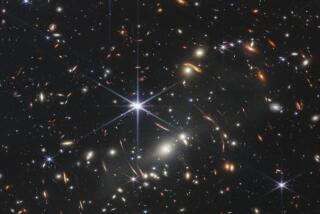Asteroids, Ice Keys to New Life Theory
- Share via
SAN FRANCISCO — All life on Earth may owe its origin to fire and ice, as a rain of immense meteorites shattered the thick ice sheathing a primordial ocean more than 4 billion years ago, according to a new theory presented by scientists Sunday.
In a sharp departure from the conventional scientific view of how life began, several leading authorities told the American Assn. for the Advancement of Science that such cataclysmic impacts may have intermittently melted frozen oceans and triggered in their depths a cascade of chemical reactions that spontaneously created the elemental building blocks of life.
Redolent with religious and philosophical implications, the origin of life is the fundamental mystery of organic chemistry. By what process were the molecules that led to living things first assembled?
The new theory was developed by Jeffrey Bada, a respected authority on marine chemistry at the Scripps Institution of Oceanography, and Stanley Miller, the UC San Diego chemistry expert who first demonstrated in the laboratory how all the elements needed for life could spontaneously combine to create the amino acids, simple sugars and DNA bases that are necessary for life.
To frame their theories about the beginning of life, scientists only have the rules of chemistry and informed speculation about the state of the early Earth. There are no fossils or direct geological or astronomical evidence to guide them as they try to understand chemical reactions that took place when the Earth was barren and the sun was a fainter, cooler star.
Some scientists have suggested that primeval lightning may have sparked the crucial chain reaction in an atmosphere rich in ammonia and methane--just like the famous experiment Miller carried out in 1953, but on a planetary scale. Other experts have proposed that comets or cosmic dust might have carried the seeds of life to Earth.
Still others argue that the sun was so faint in its youth that the Earth must have been a frozen ball--unless it was warmed by a “greenhouse” atmosphere rich in carbon dioxide. That, however, would have smothered any organic chemical reaction.
The new theory is an effort to reconcile those contradictions, along with the requirements of organic chemistry and what planetary scientists have determined about the violent conditions on primitive Earth 4 billion years ago.
The result is a plausible explanation of how, under a devastating celestial bombardment, life began over and over and over again.
“There is no evidence that the origin of life took place only once. The origin of life may have taken place several times, and several times it may have been annihilated by impacts,” said Bada, who presented the new theory Sunday at the annual conference of the nation’s oldest and largest organization of scientists.
The presentation drew a packed auditorium of planetary scientists and chemists in large part because of Miller’s stature as a leader of such theorizing for four decades.
Bada and Miller believe that the organic molecules that serve as seeds of life arose at the bottom of ancient oceans crusted with ice 1,000 feet thick. At that time, the sun was so faint that the temperature at Earth’s surface never rose higher than 40 degrees Fahrenheit below zero, according to planetary scientists.
The ice would have served as a blanket to keep most of the ocean warm and fluid. Scientists believe those ancient oceans could have been more than two miles deep.
“You have a very frozen planet. Most of the ocean was still unfrozen,” Bada said. “And this is where I think you could have some pretty interesting organic chemistry.”
Battered by the fiery impacts of asteroids greater than 50 miles in diameter, the ice would have thawed and refrozen repeatedly, perhaps as often as every 100,000 years.
“Impacts could periodically melt this frozen planet,” Bada said.
Under the new theory, any organic material would have been trapped beneath the ice when the oceans refroze, preventing the raw material for organic molecules from being destroyed in the atmosphere. Thus--in that rich, protected stew--the first self-replicating molecules could have come into being, Miller and Bada said.
Subsequent impacts could have easily annihilated those precursors to life, the scientists suggested, just as a large meteor impact is widely believed to have caused the demise of the dinosaurs about 65 million years ago.
“The Earth’s surface was being traumatized by impacts,” said David Stevenson, a professor of planetary sciences at Caltech. “Along would come an impact and blast the hell out of an area and destroy early life. Life may have started several times over.
“So perhaps we should ask not when life began, but when did life persist?” he said.
Stevenson, like Miller and Bada, said he was skeptical of the theory that comets or meteorites might have seeded Earth with the building blocks of life. Although it is well-known that meteorites and cosmic dust can contain some amino acids, there is no evidence that enough survived impact to fertilize the planet.
Efforts to find traces of extraterrestrial amino acids in Antarctica and Greenland, where they might have been preserved in pristine ice, turned up only one sample that shows any trace of organic compounds from outer space. That trace, from ice that formed more than 4,000 years ago, is so faint that scientists believe it is proof that “cosmic rain” could not have served as the source for the chemical reactions that led to life.
“The amounts are pitifully small,” Bada said. “It is a pretty dilute soup to do any kind of organic chemistry.”
However the process was triggered, life on Earth began in “a geological instant,” the scientists said Sunday. But their notion of an instant does not quite match that of most people.
“We have been adding up the time it might take for life to develop,” Miller said. “The whole process could take place in 10 million years or less.”






